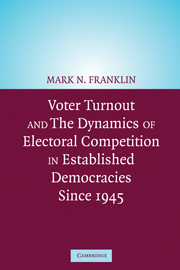Book contents
- Frontmatter
- Contents
- Figures
- Tables
- Preface
- The Authors
- Introduction
- 1 Confronting the Puzzles of Voter Turnout
- 2 A New Approach to the Calculus of Voting
- 3 The Role of Generational Replacement in Turnout Change
- 4 Rational Responses to Electoral Competition
- 5 Explaining Turnout Change in Twenty-Two Countries
- 6 The Character of Elections and the Individual Citizen
- 7 Understanding Turnout Decline
- 8 The Turnout Puzzles Revisited
- APPENDICES
- Bibliography
- Author Index
- Subject Index
8 - The Turnout Puzzles Revisited
Published online by Cambridge University Press: 08 February 2010
- Frontmatter
- Contents
- Figures
- Tables
- Preface
- The Authors
- Introduction
- 1 Confronting the Puzzles of Voter Turnout
- 2 A New Approach to the Calculus of Voting
- 3 The Role of Generational Replacement in Turnout Change
- 4 Rational Responses to Electoral Competition
- 5 Explaining Turnout Change in Twenty-Two Countries
- 6 The Character of Elections and the Individual Citizen
- 7 Understanding Turnout Decline
- 8 The Turnout Puzzles Revisited
- APPENDICES
- Bibliography
- Author Index
- Subject Index
Summary
This book opened by setting out a number of puzzles that face anyone who tries to investigate the reasons why voter turnout levels vary from one election to another. Some of these puzzles arose because relationships expected on theoretical grounds were not observed in practice (or because relationships were observed in practice that were not expected on theoretical grounds). Rather more of them were puzzles about how properly to investigate what turns out to be an elusive phenomenon.
The book has addressed these puzzles in different ways. Puzzles about how to proceed were addressed mainly on the basis of inductive and deductive argument, and the success of the book in arriving at coherent and mutually supportive findings vindicates those arguments. In some cases, multiple approaches were adopted in parallel because it was not clear that one approach or another could be established as correct. Thus it was decided to address turnout at three different levels of analysis because turnout is a phenomenon that is inherently multilevel in nature. Similarly, multiple estimation strategies were employed in Chapter 5 because, with time-series data, it seemed important to validate the findings by arriving at them in several ways.
Puzzles about relationships were addressed by developing two bodies of theory involving (1) why people vote and (2) how the mainsprings of voting behavior translate into turnout variations. These theories were then tested with data at the three different levels of analysis and largely confirmed.
- Type
- Chapter
- Information
- Voter Turnout and the Dynamics of Electoral Competition in Established Democracies since 1945 , pp. 201 - 224Publisher: Cambridge University PressPrint publication year: 2004



